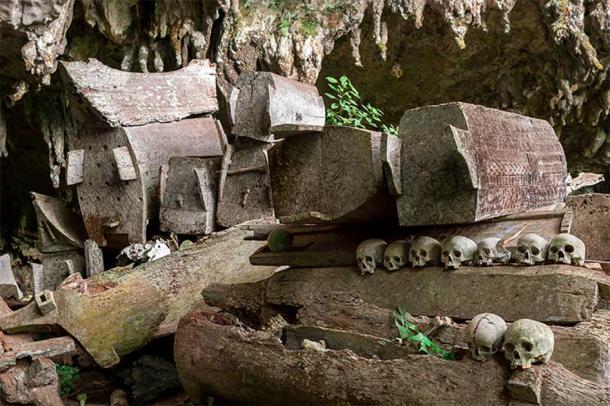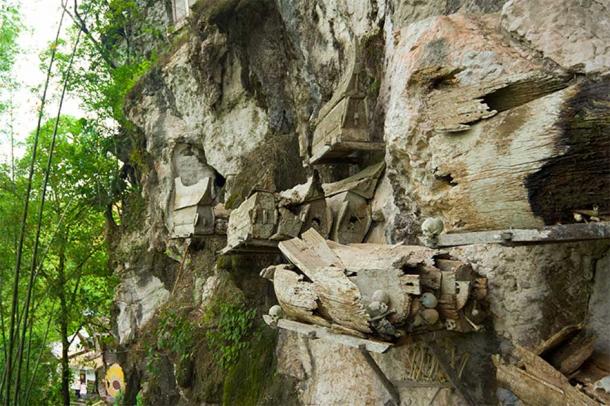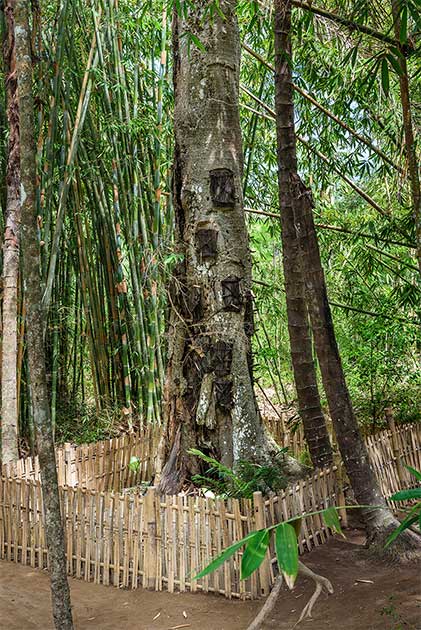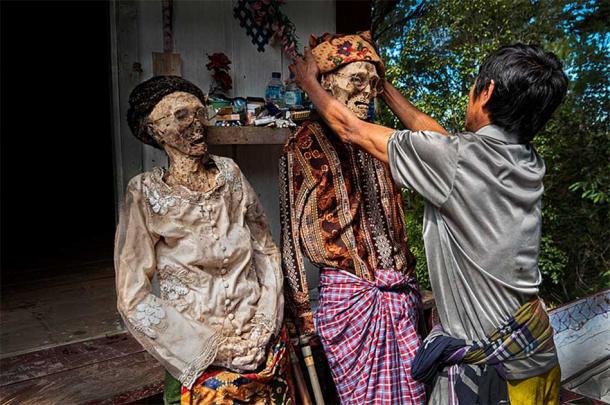
Elaborate Funeral Rituals and Exhumation of the Dead in Toraja Culture
The unforgettable Tana Toraja is a regency located in the picturesque mountains of South Sulawesi in Indonesia. This region is home to the indigenous Torajan people, whose way of life is deeply intertwined with death. However, death is not perceived as a bleak event but rather as a joyous celebration of life.
The Torajans celebrate the passing of a loved one, much like a going-away party, with a grand funeral that is attended by the entire family and village. These unique and intricate funerary customs have been celebrated for centuries, making them some of the most complex funeral traditions in the world. These ancient traditions are a testament to the Torajans' deep reverence for life and their rich cultural heritage.

The funeral rituals of Tana Toraja are evidenced in the spectacular cave tombs which can still be visited today. (ksl / Adobe Stock)
The Extravagant Funeral Rituals of Tana Toraja
The population of the Toraja is approximately 650,000, of which 450,000 still live in the regency of Tana Toraja, meaning “Land of Toraja”. While most are Christian, others are Muslim, and a minority still retain the local beliefs known as Aluk Todolo, or “Way of the Ancestors”, which are most visible during funeral festivities and burial customs.
Before the 20th century, Torajans lived in autonomous villages, where they practiced animism, the worldview that non-human entities, including animals, plants and often even inanimate objects or phenomena possess a spiritual essence. They were relatively untouched by the outside world until Dutch missionaries arrived to convert the Torajan highlanders to Christianity. Nevertheless, even those that follow other religions in Tana Toraja, still converge when it comes to ancient funeral customs.
During their lives, the Tarajans work extremely hard to accumulate wealth. But unlike other societies, the Tarajans do not save their money to give themselves a good life, rather they save for a good send off in death. In fact, it is the extravagance of the funeral, not the wedding, which marks a family’s status.
- Traditional Funerary Rites Provide a Glimpse at Mystery Neolithic Vietnamese Culture
- Unique and Unsettling: The Hanging Coffins of Sagada, Philippines
Funeral ceremonies are incredibly important to the Tarajans and are often held weeks, months, or even years after the death of a person to give the family of the deceased time to raise enough money for expenses. In the Tarajan culture, a body is not buried until the funds have been raised.
Many people go deeply into debt in order to hold a funeral ceremony and it is not uncommon for a young man, afraid of being burdened by debt, to postpone or cancel his marriage if a grandparent of the girl he loves is old enough to die soon. The funerals are raucous affairs involving the whole village and traditionally last for days or even weeks. Specifically, a funeral reinforces the eternal bond between the living and the dead.

The dead are buried in Cliffside hanging wooden coffins as part of the funeral rituals of the culture of the Torajan people. (Pius Lee / Adobe Stock)
Caring for the Dead in Funeral Rituals of the Tarajan Culture
When a Torajan dies, family members of the deceased are required to hold a series of funeral ceremonies, known as Rambu Soloq, which take place over many days. During this time, the deceased is not buried but is embalmed and stored in a traditional house under the same roof with his or her family.
Until the funeral ceremonies are completed, the person is not considered to be truly dead but merely suffering an illness. The dead relative is referred to simple as “a person who is sick” or “the one who is asleep.”
Remarkably, this phase could last several years after death, depending on how long it takes the family to raise money. During this time, the deceased family member is symbolically fed, cared for and taken out, and is very much a part of their relative’s lives.
Their ceremony begins when funeral visitors attend a buffalo-slaughtering field. Family members are required to slaughter buffaloes and pigs as they believe that the spirit of the deceased will live peacefully thereafter, continuing to herd the buffaloes that have come to join him or her. Before being sacrificed according to a strictly defined procedure, the animals take part in trials of strength known as tedong silaga.
After the sacrifice, the meat is distributed to the funeral visitors in accordance with visitors' positions in the community, and the spirit of the deceased is also entitled to a portion of meat, known locally as Aluk Todolo. The heads of the buffaloes are returned to what is locally known as puya (a site for the soul or spirit of the dead person) and their horns placed in front of the house of the kin. The more horns that decorate the front of the house, the higher the status of the deceased.
The body is not buried until the eleventh day of the ceremony, although they are not technically buried – the final resting place is in a cave up on the cliff. The soul of the deceased is thought to linger around the village until the funeral ceremony is completed, after which it begins its journey to the land of souls.
A wood-carved effigy called tau tau, carved with the likeness of the dead person is then placed in the balcony of the tomb to represent the dead and watch over their remains. Unfortunately, so many tau tau effigies have been stolen to be sold to tourists that people have started to keep them in their homes.
In one region, known as Ke’te’ kesu’, the dead are not placed in cliff-dug graves, but in wooden caskets hanging from the side of cliffs. The coffins are beautifully decorated with geometrical shapes, but over time the wood begins to rot and the bleached bones of the deceased often become exposed.
The smallest of the Toraja burial grounds are the “Baby Trees” where the tribe’s young are placed. If a child dies before he has started teething, the baby is wrapped in cloth and placed inside a hollowed out space within the trunk of a growing tree and covered over with a palm fiber door. The belief is that as the tree begins to heal, the child’s essence will become part of the tree. Dozens of babies may be interred within a single tree.

The smallest of the Toraja burial grounds are the “Baby Trees” where the tribe’s young are placed according to local funeral rituals. (Elena Odareeva / Adobe Stock)
Ma’Nene: The Ceremony of Cleaning Corpses
Every year in August, a ritual called Ma’Nene, or the Ceremony of Cleaning Corpses, takes place in which the bodies of the deceased are exhumed to be washed, groomed and dressed in new clothes. Damaged boxes are fixed or replaced. The mummies are then walked around the village by following a path of straight lines.
Following these straight lines is maybe the most important part of the ceremony. According to the myth, these lines are connected with Hyang, a spiritual entity with supernatural power. As this entity only move in straight lines, the soul of the deceased body must follow the path of Hyang during this funeral ritual.
According to the ancient Torajan belief system, the spirit of a dead person must return to his village of origin. So if a person died on a journey, the family would go to the place of death and accompany the deceased back home by walking them back to the village. In the past, people were frightened to journey far, in case they died while they were away and were unable to return to their village.

The Ma’Nene, or the Ceremony of Cleaning Corpses, takes place every year, with the exhumation of bodies which are then washed and groomed. (RaiyaniM / CC BY-SA 4.0)
Understanding Toraja Beliefs and their Funeral Rituals
In Toraja mythology, the ancestors of Torajan people came down from heaven using stairs, which were then used by the Torajans as a communication medium with Puang Matua, the Creator. The cosmos, is divided into the upper world (heaven), the world of man (earth), and the underworld.
At first, heaven and earth were married, then there was a darkness, a separation, and finally the light. The Torajans traditionally believe that death is not a sudden, abrupt event, but a gradual process toward Puya, the land of souls or afterlife.
- The Decomposing Bodies of Skull Island: The Unique Funerary Custom of Trunyan
- Nine Weird and Wonderful Facts about Death and Funeral Practices
The Aluk Todolo belief system still very much governs the life of the society, demonstrated by Toraja cosmology, ceremonies, settlement arrangement, houses, decorations, the role of water buffalo, and of course, their funeral rituals. According to UNESCO, the Torajan cosmology represents an ancient cosmology common to pre-state Southeast Asian communities which is now vanishing.

The dead are buried in elaborate funeral rituals, such as at this burial site in Tana Toraja. (Elena Odareeva / Adobe Stock)
Tourism in Tana Toraja and its Impact on Ancient Funeral Rituals
Tana Toraja is now the second most popular destination for tourists in Indonesia after Bali. However, tourism in Tana Toraja is very much a double-edged sword. The influx of foreign visitors boosts the economy of the local region and “motivates” the local people to keep their ancient customs alive, partly for the benefit of visitors and partly for their own benefit.
These traditions and Tana Toraja funeral rituals may have otherwise become lost due to the influence of outside forces over the years. UNESCO claimed that their heritage has an “indispensable scientific value as a source of analogy to study the past” and “the cultural landscape created based on local wisdoms may bring awareness on the nature-culture relation.”
Tourism has not come without its costs. Developers have been known to exploit the local people and many of their sacred relics, like the tau tau, have been bought or stolen by tourists. Nevertheless, Torajan heritage has been handed down from generation to generation for at least 700 years, but probably as far back as prehistoric times, and it is still very much a living culture.
It survived invasions from the Buginese in the 17th century, the influx of Dutch missionaries in the early 20th century, and it still endures today. UNESCO has argued that the importance of preserving Torajan traditions lies in the fact that “such complicated and expensive ceremonies sustain many aspects of prehistoric megalithic culture which cannot be found in any other part of the world today.”
Top image: A traditional burial site in Tana Toraja, whose culture is known for elaborate funeral rituals. Source: fabio lamanna / Adobe Stock
By Joanna Gillan
References
Adams, K. 1997. “Ethnic Tourism and the Renegotiation of Tradition in Tana Toraja (Sulawesi, Indonesia)” in Ethnology 36(4): 309-320.
Bennett, A. 11 March 2016. “When Death Doesn’t Mean Goodbye” in National Geographic. Available at: https://www.nationalgeographic.com/magazine/article/death-dying-grief-funeral-ceremony-corpse
Ministry of Culture and Tourism of the Republic of Indonesia. 2009. “Tana Toraja Traditional Settlement” in UNESCO. Available at: https://whc.unesco.org/en/tentativelists/5462/
Swazey, K. 2013. “Life that doesn't end with death” in TED. Available at: https://www.ted.com/talks/kelli_swazey_life_that_doesn_t_end_with_death?language=en
Yamashita, S. 1994. “Manipulating Ethnic Tradition: The Funeral Ceremony, Tourism, and Television about the Toraja of Sulawesi” in Indonesia. https://doi.org/10.2307/3351103
















Comments
Hi I am researching the toraja culture for an essay for my nvq and was wondering if they had death certificates and if so what date do they put as date of death? As they don't class the deceased as dead untill after the funeral service but they say that can be weeks months or even years after as have to raise the funds for the funeral service first. If anyone know or know of anywhere I could try to be able to find out it would be greatly appreciated. I like to know the facts before I write about something and this was a question that popped into my head although weird (this is usual for me lol) I have to find out the answer or it bugs me untill I do lol thank you x
Thank you Sadek.
What an informative article it is! Toraja is really a mountainous region. Most of the people of the region are very much industrious. They work hard to accumulate wealth.
Luther a guide from Toraja can take you by motorbike or car to this wonderful place. http://www.tanatorajatourssulawesi.com/ has all his tours
Hi guys, find more Toraja photos at http://www.torajatreasures.com/en/photo
Interesting article anyway.. heheee
Pages